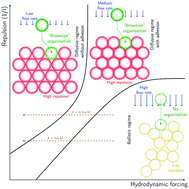Microstructure of the near-wall layer of filtration-induced colloidal assembly
Abstract
This paper describes an experimental study of filtration of a colloidal suspension using microfluidic devices. A suspension of micrometer-scale colloids flows through parallel slit-shaped pores at fixed pressure drop. Clogs and cakes are systematically observed at pore entrance, for variable applied pressure drop and ionic strength. Based on image analysis of the layer of colloids close to the device wall, global and local studies are performed to analyse in detail the near-wall layer microstructure. Whereas global porosity of this layer does not seem to be affected by ionic strength and applied pressure drop, a local study shows some heterogeneity: clogs are more porous at the vicinity of the pore than far away. An analysis of medium-range order using radial distribution function shows a slightly more organized state at high ionic strength. This is confirmed by a local analysis using two-dimension continuous wavelet decomposition: the typical size of crystals of colloids is larger for low ionic strength, and it increases with distance from the pores. We bring these results together in a phase diagram involving colloid–colloid repulsive interactions and fluid velocity.



 Please wait while we load your content...
Please wait while we load your content...